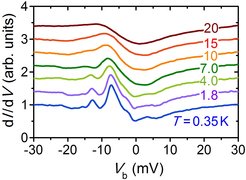When being superficial becomes a virtue
Over the past years, topology has increasingly become a center of attention of condensed matter physics. One of the fascinating insights is that even Kondo insulators may develop topological order. Such topological Kondo insulators can give rise to exquisite electronic properties due to their spin-momentum locked Dirac-cone-like band structure. It has been suggested that the required opposite parities between valence and conduction band along with strong spin-orbit coupling can very likely be realized in the correlated material SmB6. This material has a long history of puzzling properties – in particular at low temperatures – ranging from an intermediate Sm valence to so-called in-gap states at very low energies and a resistance plateau below about a few Kelvin.
In an effort to resolve some of these issues, scanning tunneling microscopy and spectroscopy (STM/STS) was conducted down to a temperature of 0.35 K and in applied magnetic fields. A major advantage of this measurement technique is its excellent energy resolution (of about 0.5 meV in our case) while at the same time providing local information about the surface topography. In fact, the exact surface topography of SmB6 is another enigma: while the majority of a cleaved SmB6 surface is atomically rough, also patches of reconstructed surfaces areas were typically found to coexist with atomically flat B- and/or Sm-terminated surface areas. Utilizing STM/STS allowed us to identify the fine structure of the hybridization gaps on large and non-reconstructed surfaces in the sub-meV scale. Moreover, by measuring the impurity, magnetic-field and temperature dependence of the STS spectra, we are able to attribute bulk and/or surface contributions to these states.
A particularly intriguing finding was a new energy scale of ≃ 7 K, which provides an important piece of the puzzle for a unified picture of SmB6. Clearly, at the surface there is a reduced screening of the local moments due to the broken translational symmetry. As a result, the Kondo temperature of the outmost layer, TSK, can be strongly suppressed, giving rise to a modified band structure. Such a scenario, referred to as surface Kondo breakdown, has very recently been discussed in the literature. However, at low enough temperatures, i.e. below TSK, the surface f-electrons gradually hybridize with conduction electrons at the surface and form a weakly dispersive band close to the Fermi energy EF. Remarkably, very narrow peaks with strongly temperature-dependent STS spectra near EF as observed in our experiments are considered as a smoking gun evidence for the suggested surface Kondo breakdown scenario. Based on our experimental results, TSK is around 7 K, i.e. about an order of magnitude smaller than TK ~ 50 K of bulk SmB6. In addition, indications for the formation of heavy quasiparticle surface states were observed which supply an additional tunneling channel into the f-states and provide a very likely origin for the metallic surface states.
Consequently, our high-resolution data provide very detailed and unprecedented insight into the electronic structure of SmB6, which reconciles many current discrepancies reported for this compound.
SW / CPfS

Atomically resolved surface topography of SmB6 indicating a very low defect density. Zoomed inset: the square arrangement of the surface atoms results from the cubic lattice structure of SmB6 and suggests a B-terminated surface.

The differential tunneling conductance dI/dV as measured by utilizing our Scanning Tunneling Microscope (STM) on the same surface for which the topography is shown exhibits a very strong temperature dependence, particularly at low temperatures.

